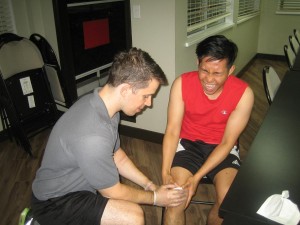Knee pain can be due to any weakening condition that can affect daily movements of the individual. Some individuals can walk on flat surfaces without any knee pain, but eventually when climbing stairs, the pain can be felt. It is a frustrating condition especially for people who have to climb stairs in their houses.
[youtube url=”https://www.youtube.com/watch?v=DCg8tuneIPo”]It is usually the front part of the knee or the patellofemoral joint that is affected while climbing stairs. It is the joint where the knee cap is located in the front groove of the lower end of the thigh bone. The joint of the knee is composed of tendons, cartilage, bones and synovial fluid, blood vessels and nerves. The cartilage functions in protecting against friction between the two bones while the tendons help in supporting the bones to remain stable while synovial fluid functions as a lubricant.
Causes

- Knee pain can be caused by athlete’s knees or runner’s knee which affects individuals who are overusing the knee repeatedly. Performing movements that require bending and extending the knee joint such as walking and running long distances and frequent kneeling. The affected person can feel pain and tenderness on the kneecap with mild ache on both sides of the knee especially when climbing.
- Sometimes, it can be caused by misalignment of the kneecap or moves out of place on the groove of the thigh bone. It happens due to weakness on one side of the thigh muscle while the stronger side will pull the kneecap to its side and result to pain while climbing.
- Injury to the kneecap tendon due to overuse of quadriceps muscles which is located in the anterior part of the kneecap. Kneecap tendon injury is common in runners and walking for long hours.
- Knee pain can be caused by knee arthritis. The cartilage that functions as a padding between the bones in the knee are damaged due to wear and tear caused by rubbing of bones and pain and becomes severe with any type of movement.
Treatment
- Get plenty of rest especially the joint of the knee and avoid performing rigorous activities. Avoid running, brisk walking for long hours and other athletic activities. Normal walking to perform regular work should be continued on flat surfaces.
- Apply an ice pack on the affected knee in order to help lessen inflammation of the tendons and muscles that cause pain while climbing stairs. Wrap an ice pack or a few ice cubes in a towel and apply over the knee for at least 10 minutes for 2-3 times every day. Avoid applying an ice pack directly on the skin in order to help prevent frostbite.
- While resting, keep the knee elevated above the level of the heart in order to help with proper circulation of blood in the affected area. It also helps nourish the injured tendons and muscles and for fast healing of the affected knee.
- Massage gently the affected knee using coconut or olive oil to lessen the pain and inflammation in the knee.
- Take the prescribed over-the-counter pain and anti-inflammatory medication in order to help relieve of pain and inflammation due to knee pain
